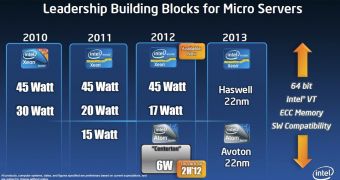Intel just refuses to let the Atom architecture die its rightfully deserved death. After pulling an ugly prank with the “performance is irrelevant netbook” concept three years ago, Intel is now pushing Atom strong in the server market.
Intel’s General Manager for the Cloud Infrastructure Group, Mr. Jason Waxman, presented his vision on what the micro server evolution will look like during the next year.
While end-users finally understood what a hoax Atom was and are now stirring away from netbooks, Intel wants to use its “Jedi-Knight powers” to hypnotize the corporate market into buying its low-performance processor.
In our humble opinion, they have a strong chance on achieving their goal in the short term, as the corporate market is usually the first victim of Intel’s marketing.
There is a certain market niche for these micro servers using low-power processors, but Intel’s In-Order architecture is certainly not the best solution.
ARM’s Cortex A9 and Cortex A15 cores are simply better and consume even less power. DELL demonstrated what can be achieved with ARM architecture in a server chassis.
AMD’s Out-of-Order architecture is also offering superior performance, while the GPU compute potential is exponentially higher.
It will be an interesting fight on the micro server front next year.
Editor’s Note:
In a recent talk I had with several scientists working for Schneider Electric or ST Micro at Grenoble INPG, I was amazed how professionals are completely mind-set on Intel. One even told me that he “wouldn’t use AMD on a keychain,” and none of them believed that AMD had better graphics or was able to fit in the same thermal envelope or thin format as Intel’s processors.
For people that don’t have time to do specific research to understand what the advantages or disadvantages of a certain processor architecture are, Intel’s marketing money will likely sway the deal towards the blue side.
I heard arguments like “AMD CPUs are hotter and break down in a few years,” and “Intel is quality, while AMD is cheap.”
The most amazing thing was that none of them had any knowledge that AMD actually had the superior architecture for seven years, between 1999 and late 2006.
Marketing campaigns seem to have a perfect impact on those that refuse to do the research (uninformed buyers) and on those that are too busy with their own research to do anything else (professionals/scientists).

 14 DAY TRIAL //
14 DAY TRIAL //